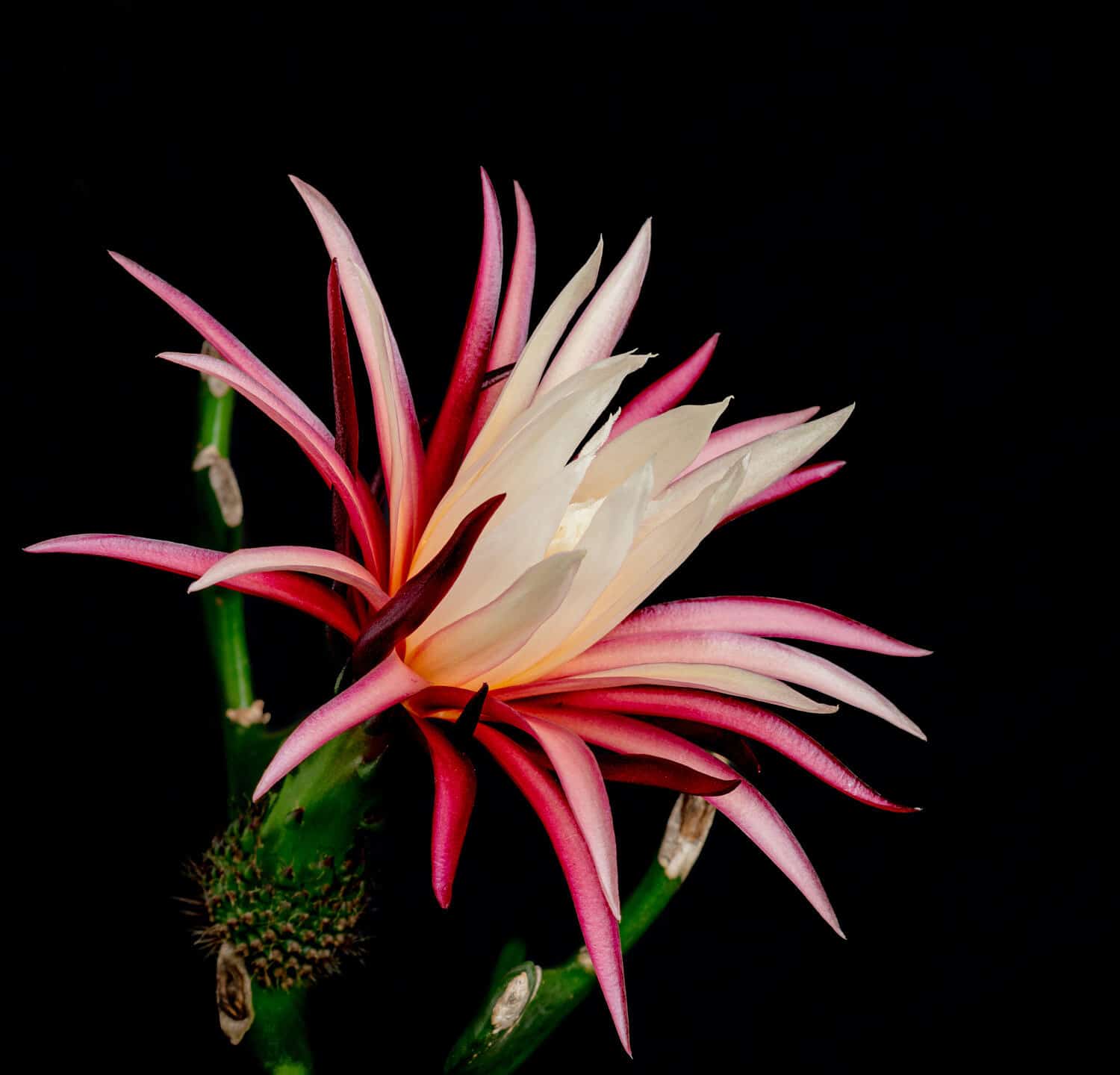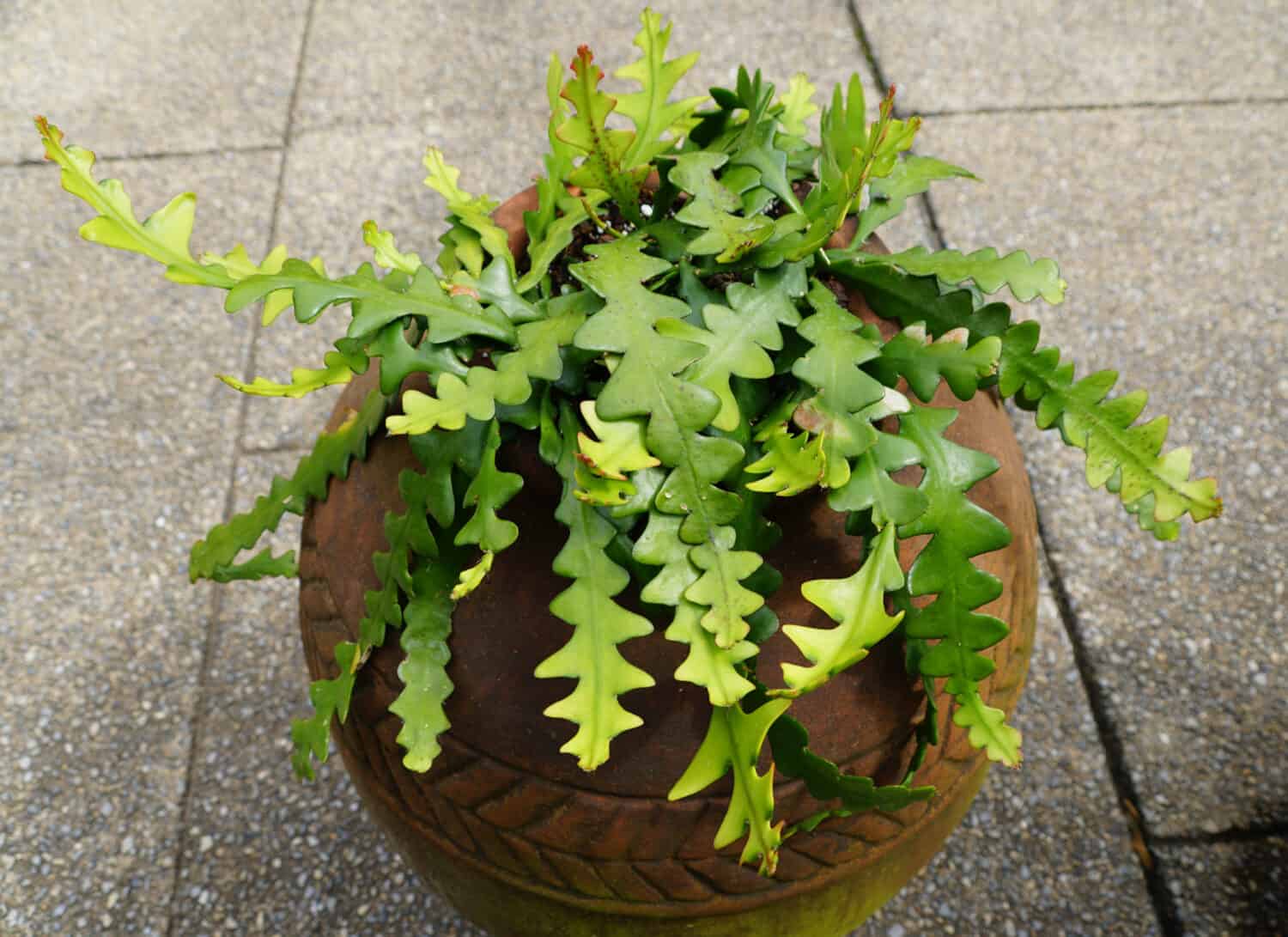The ric rac cactus is an extraordinary plant that captivates succulent enthusiasts. And it is easy to see why. The stems of this cactus are in a distinctive zig-zag pattern, and it has vibrant blooms. Thankfully, ric rac (or fishbone) cacti are some of the easiest succulents to care for. So even beginning gardeners can add this unique plant to their home or office. This article will help you get off on the right foot. We will cover different colors of ric rac cactus you may find and provide in-depth care and growing instructions.
| Scientific Name | Selenicereus anthonyanus |
| Common Name(s) | Fishbone Cactus |
| Type | Succulent |
| Size | 4-5 feet wide and 4-6 feet tall |
| Origin | Mexico |
| Blooms | Showy colors in the spring and summer |
What is the Ric Rac Cactus?
Ric rac cacti have recently gotten reclassified. Their previous scientific name was (Cryptocereus anthonyanus), and their new scientific name is (Selenicereus anthonyanus). You may run across either name in your search for these cacti.
It is native to the tropical areas of southern Mexico. The fishbone cactus is surprisingly cold tolerant given its native environment. They can survive brief periods down into the low 30s Farenheit.
The ric rac, or fishbone, cactus is known for its highly distinctive and eye-catching foliage and stunning flowers. It grows up to six feet long and six feet wide.And there are a handful of beautiful cultivars to choose from.

©Ikhwan Ameer/Shutterstock.com
Colors of Ric Rac Cacti
All ric rac cacti have shockingly deep green foliage. It has a leathery texture, which is not uncommon among succulents. The elongated stems are most typically a rich green. But they can range and feature shades of bright green or deep reddish-green. The foliage offers the perfect backdrop for the bright, vibrant blossoms.
One of the most common blooms is similar to an orchid. They are white and pink. But that is not the only blossom color available. You may also find red, yellow, purple, orange, or bicolored flowers. Look around at local nurseries and online nurseries to find the best color cactus for you.

Many ric rac cacti have white blossoms. But some cultivars have stunning, vibrantly colored flowers.
©Bruno Rodrigues B Silva/Shutterstock.com
Ric Rac Cacti in Hanging Baskets
Unlike many other members of the succulent family, fishbone cacti are ideally suited for hanging containers. Their stems develop into long, trailing arms that will take over a container on the counter or an outdoor planter.
You can show off its stunning foliage when you plant your ric rac cactus in a hanging basket (indoors or out). But more importantly, doing so will give your cactus a chance to thrive and potentially produce even more blossoms.
When Will My Ric Rac Cactus Bloom?
In general, ric rac cacti tend to bloom during the spring and summer months. During this period, you can expect your cactus to produce exquisite flowers. But there is a catch. Blossoms are short-lived and only hang around for a day. They tend to arrive in the late afternoon or early evening.
Follow all the specific care instructions below for the best chance at getting regular blossoms as early as possible. It will be worth the effort!
Caring for Ric Rac Cacti
This cactus species is relatively easy to care for and fairly hands-off. That makes it perfect for beginning and advanced plant aficionados alike. But there are a few things to pay close attention to. Once you know how to care for your new succulent, you will be ready to experience its full beauty.
Watering
You may be tempted to water your ric rac cactus like you normally would with any desert cacti. But fishbone cacti need the opposite. Since they are tropical succulents, they require slightly different care.
Ric rac cacti are not drought tolerant. They will suffer if they don’t receive enough water. However, they also don’t do well in waterlogged conditions. The best way to strike a balance is to stick your finger in the soil. Water when the top inch is dry to the touch.
Humidity
As a tropical plant, the ric rac cactus needs plenty of humidity. Most of the time, the average humidity levels of a home or office will suffice. But if you live in a dry climate or have your plant in an office building with dry central air, you will need to take additional steps. One option is to mist your cactus regularly. Alternatively, you can place a bowl of water nearby, adding a little extra moisture to the air.
Fertilizer
Any container plant needs fertilizer to help it thrive, and the ric rac cactus is no exception. Providing adequate nutrients will promote healthy growth and vibrant blooms. During the active growing season, fertilize your cactus with a balanced, diluted succulent fertilizer.
Apply the fertilizer once a month, following the manufacturer’s instructions for the appropriate dilution ratio. But don’t think that more is better. Too much fertilizer can damage your plant and impact its vigor.
Light Conditions
Finding the proper light conditions is vital for the health and longevity of your ric rac cactus. These tropical plants need bright but indirect light. They can tolerate a few hours of direct sunlight each day. But it’s crucial to avoid exposing them to intense midday sun. So if your cactus lives near a south window, hang something up that will help diffuse the bright afternoon light.
You can also add a grow light to your space if your cactus does not receive adequate indirect sunlight. Doing so will help encourage your plant to develop more intense blossoms.
Soil Type
This cactus needs a well-draining potting medium. Standard garden soil will work well, provided it is not clay-based. Otherwise, opt for a cacti/succulent blend with a good mix of things like perlite to help loosen the soil.
Growth Time
Ric rac cacti are fast-growing plants. Make sure you are prepared for the long, trailing vines to develop quickly. Find a spot on an elevated shelf or in a hanging basket early on to avoid creeping foliage.
But the good news is that since they develop quickly, you won’t have to wait long to enjoy the stunning blossoms!
Placement
Consider providing ample space for the stems of your ric rac cactus to trail or cascade naturally. Hanging baskets or elevated shelves can be ideal for displaying this cactus, allowing its beautiful stems and flowers to take center stage. Additionally, ensure that the chosen location offers the appropriate amount of light. Your cacti also need protection from extreme temperature fluctuations and adequate air circulation to prevent issues like fungal diseases.
Containers
Ric rac cacti like a slightly root-bound environment. They don’t want too much room to spread their proverbial legs. So don’t worry about regularly re-potting them. Once every few years will suffice. But feel free to switch out pots if you wanted to update the location or style. Infrequent repottings won’t hurt this plant.
Are Ric Rac Cacti Rare?
While ric rac cacti are not considered exceedingly rare in the succulent world, they possess a unique charm that sets them apart. These cacti are widely available through nurseries, online stores, and specialized succulent collectors.
However, the availability of specific cultivars or color variations may vary based on your location and the specific suppliers in your area. So it may take some effort to find the exact cactus that resonates with your preferences and desired color variations.

Ric rac cacti grow exceptionally well in tighter spaces, like containers or hanging baskets. And they can also show off their spectacular leaves in those spots.
©Khairil Azhar Junos/Shutterstock.com
Thank you for reading! Have some feedback for us? Contact the AZ Animals editorial team.







